Bust of Marcus Aurelius, older and wearing a cuirass
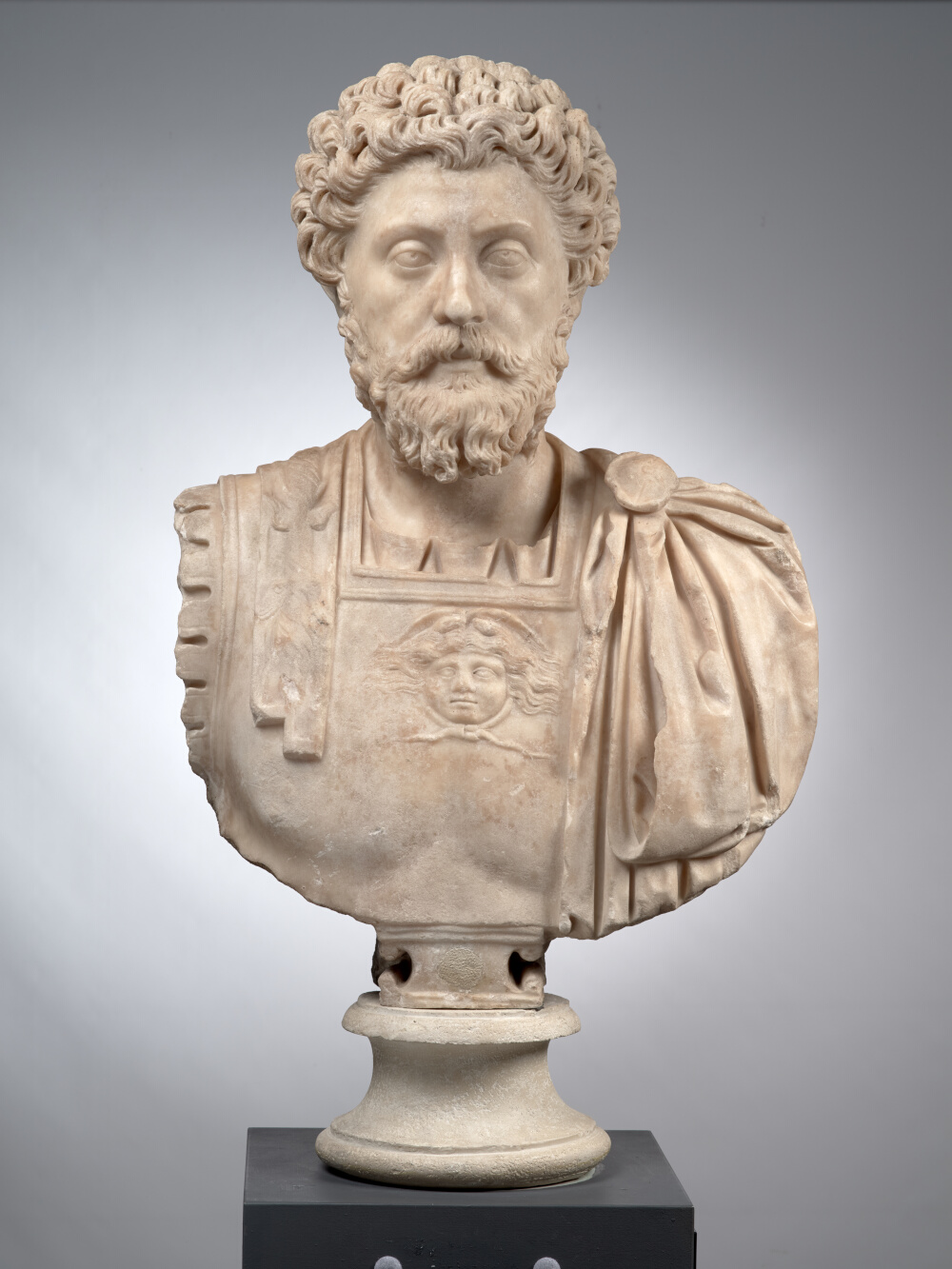
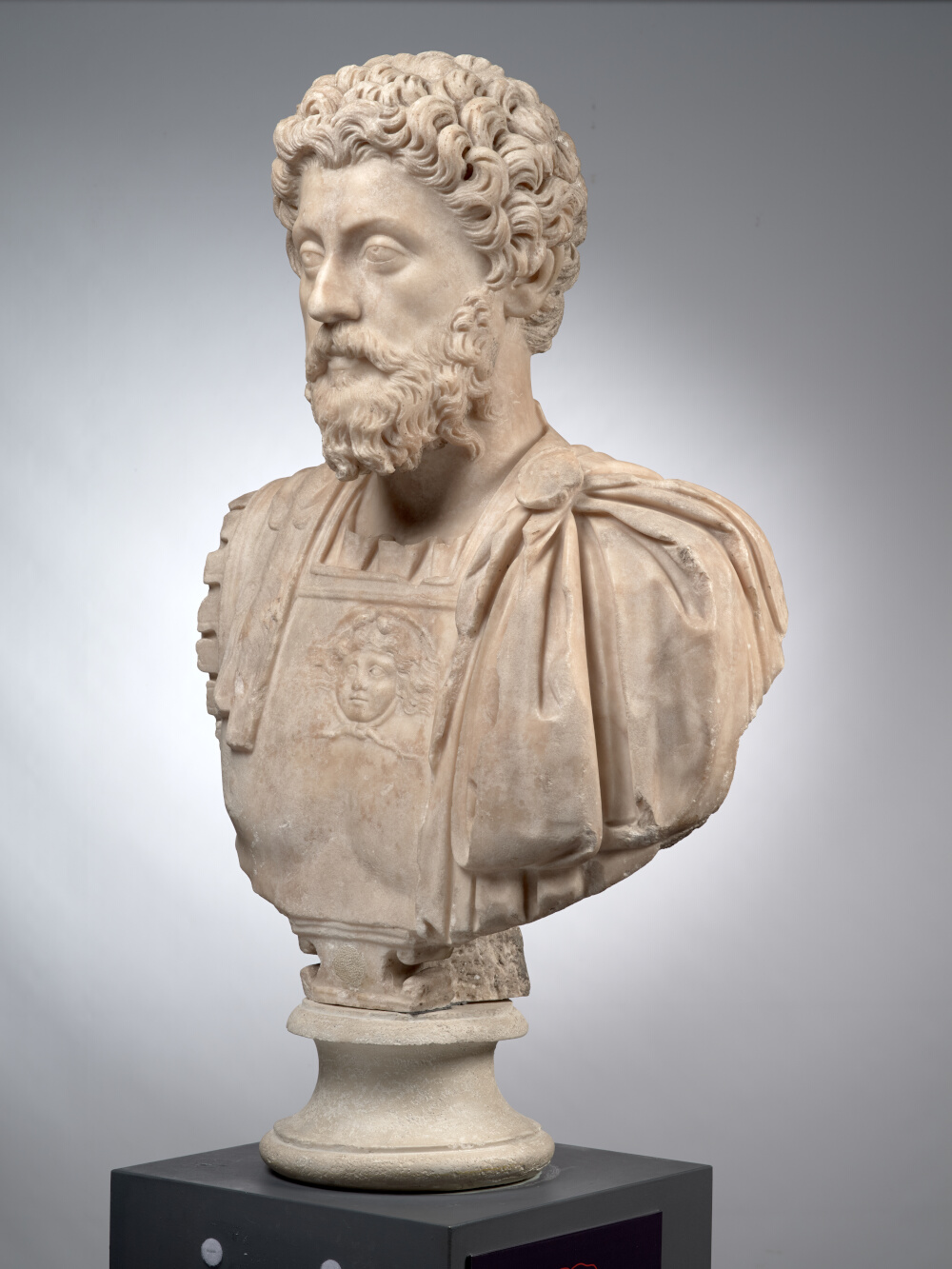
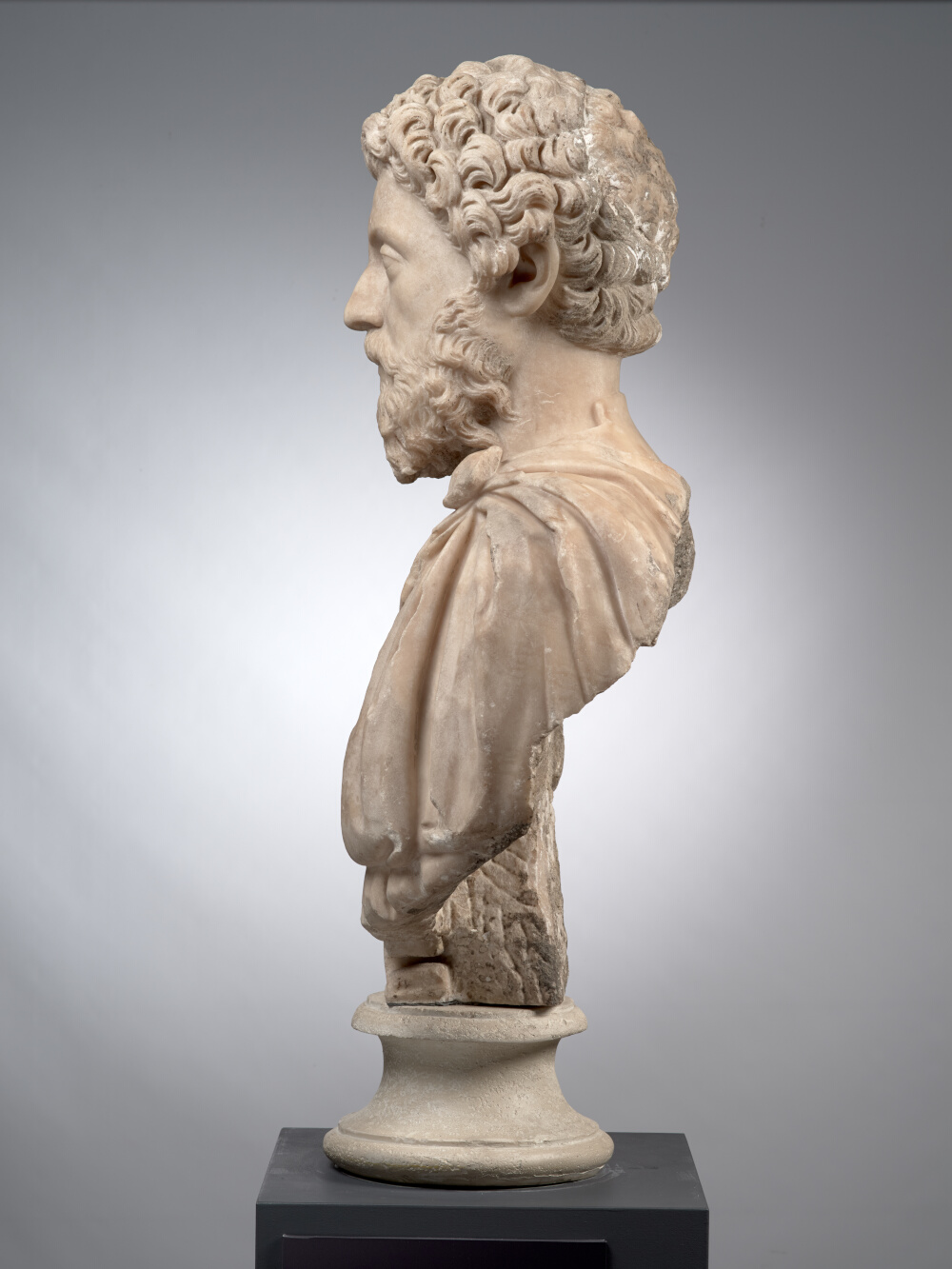
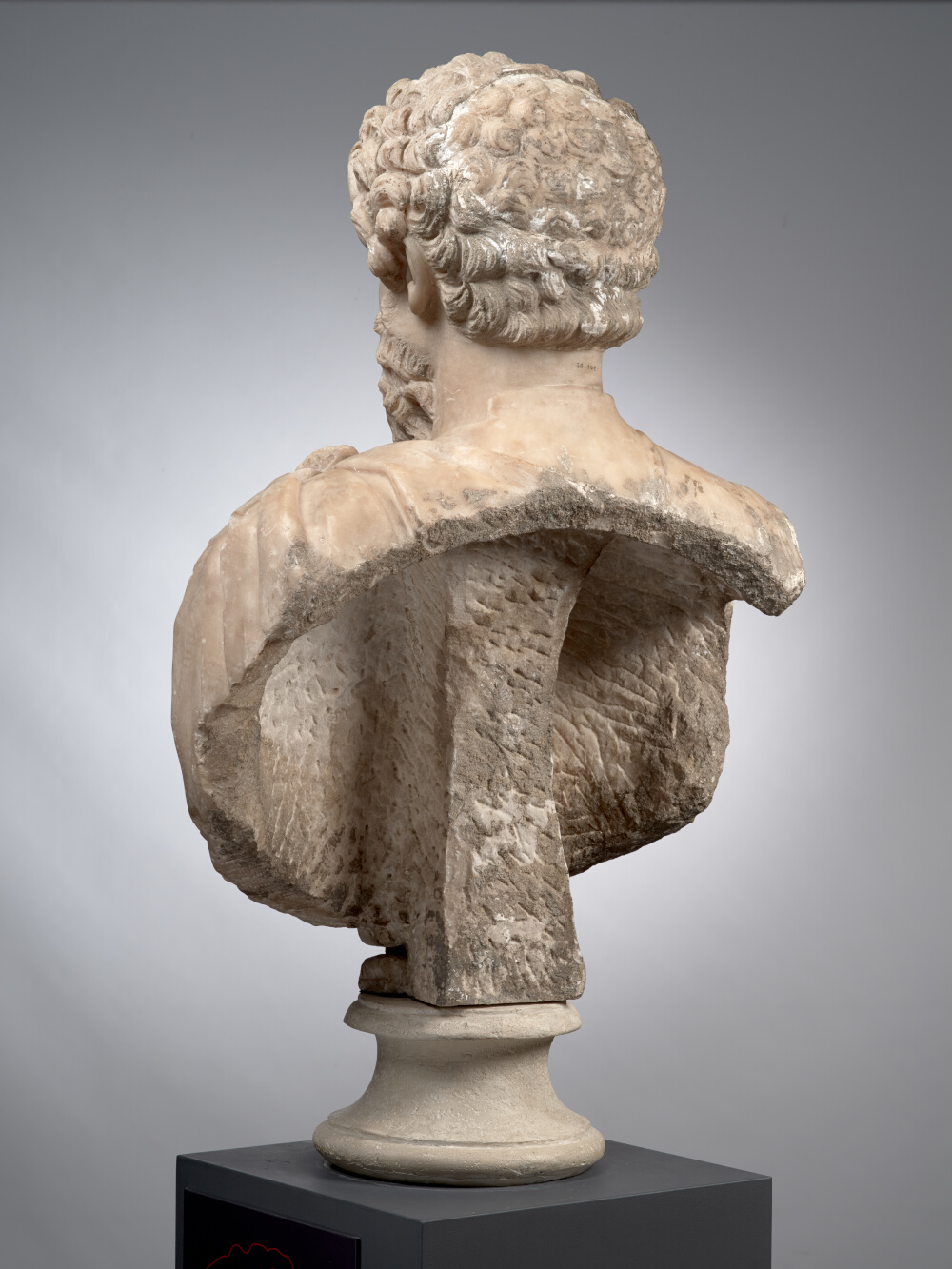
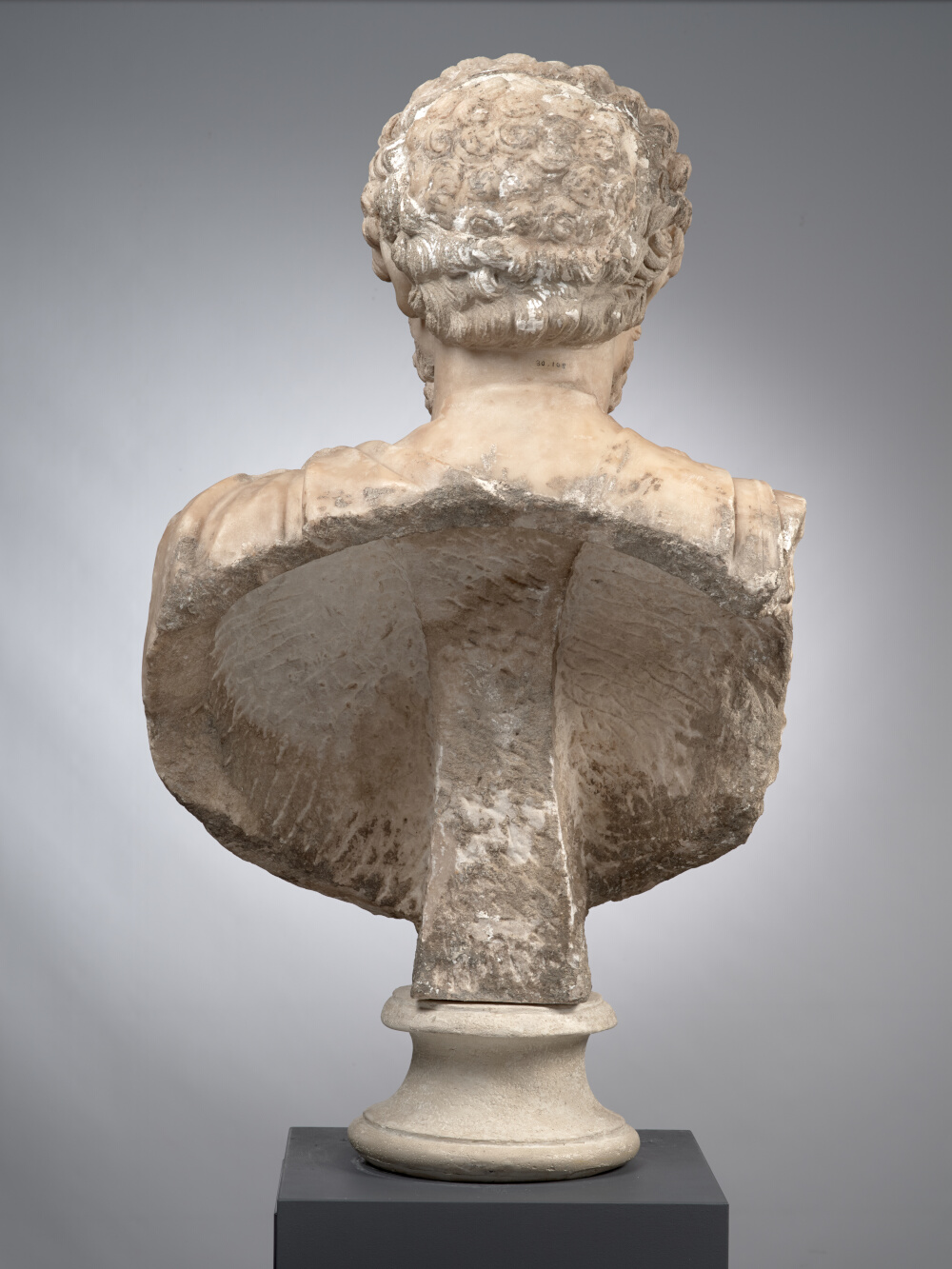
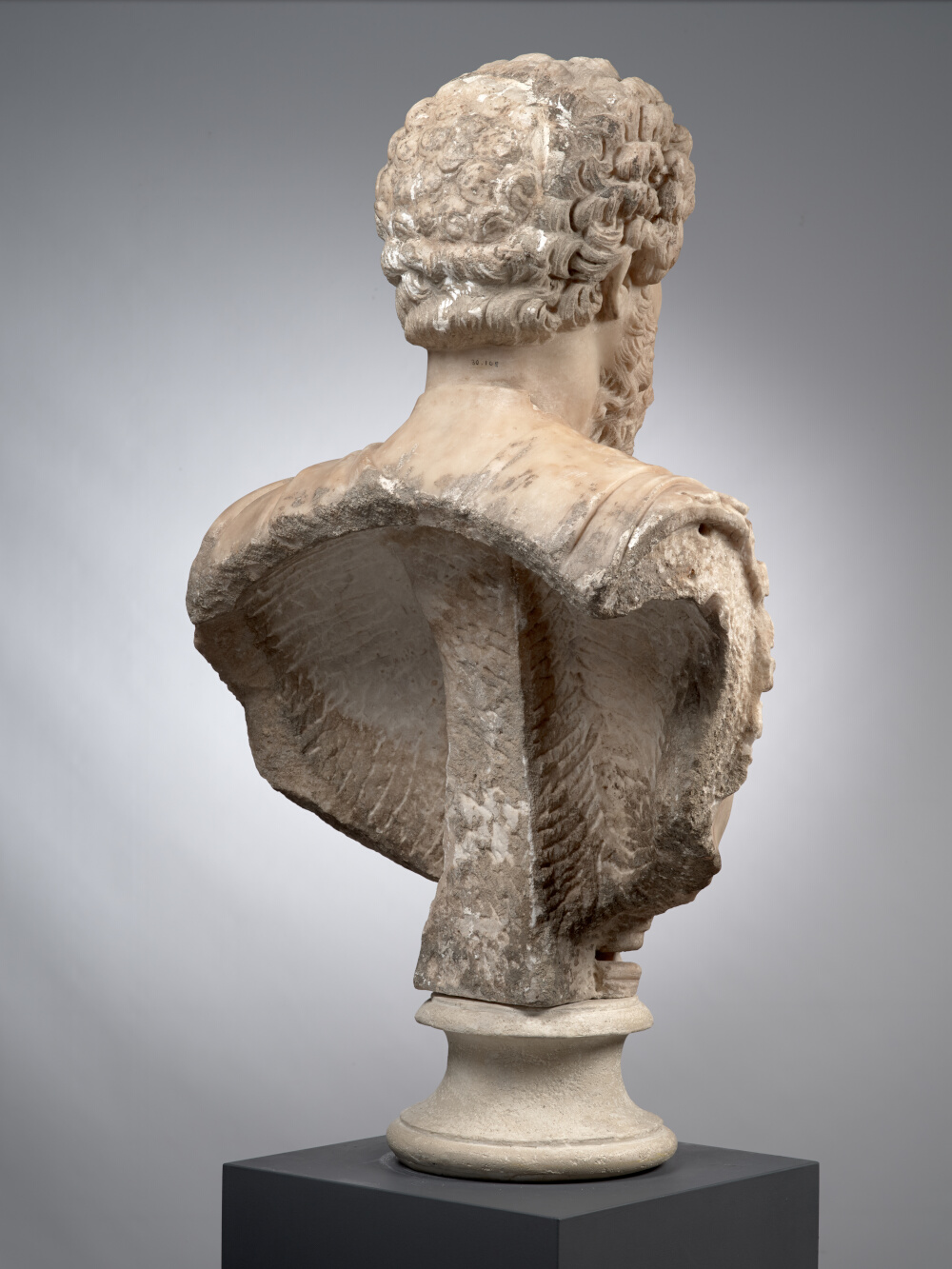
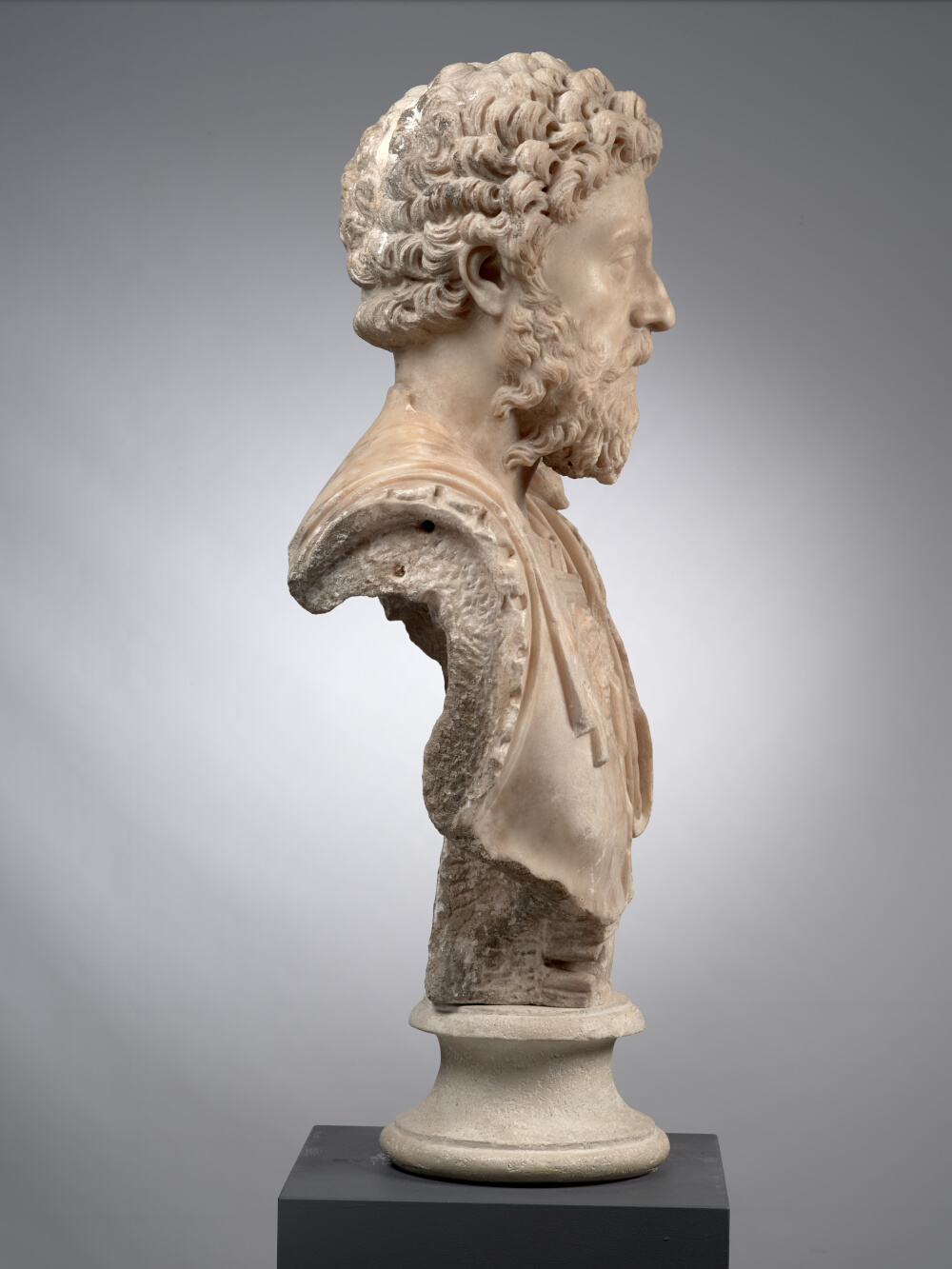
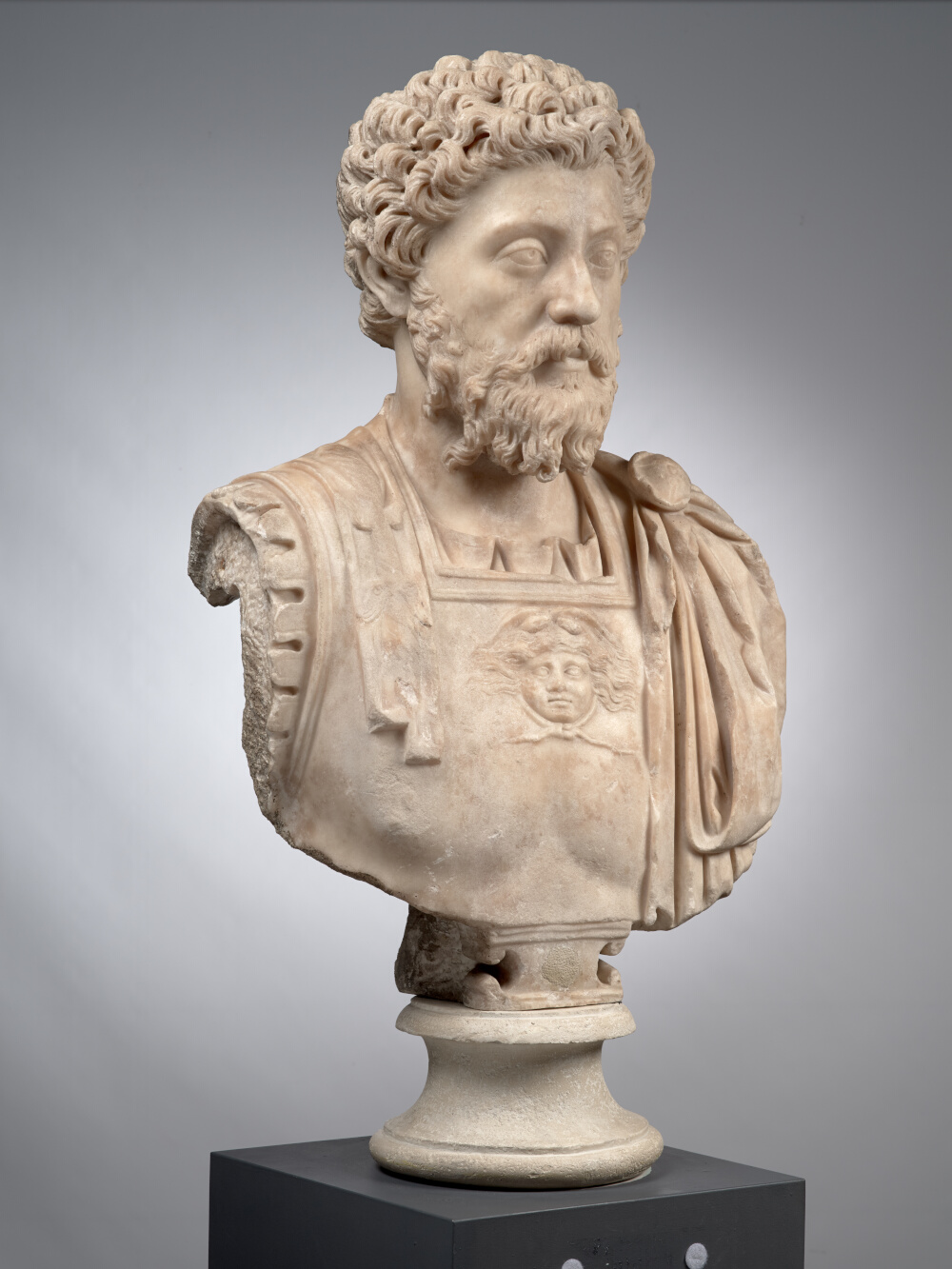
- Biographic data
- 121 - 180
Emperor from 161 to 180 - Date de création
- Between 170 and 180
- Type
- of the "IV (variant A)" type
- Material
- Dokimium marble (Turkey)
- Dimensions
- H. 76,5 x l. 53,5 x P. 29 (cm)
- Inventory number
- Ra 61 b
- Photo credits
- Daniel Martin
This second bust of Marcus Aurelius belongs to type IV of the emperor’s iconography, generally thought to date from around 170/180, that is to say from the last years of his reign. One of the most likely reasons for the creation of this portrait seems to be the important change brought about by the completely unexpected death of Lucius Verus in January or February 169, after eight years of joint reign with Marcus Aurelius, and the fact that the latter now found himself alone at the head of the Empire. But there is more: the coins minted in 171 contain clear allusions to the celebration of the decennalia (ten years of reign) on 7 March 170, and introduces the epithet Germanicus into the Emperor’s title, which crowned his military campaigns in the provinces of Germania. Could type IV have been created at this point in time?
During these same years, Marcus Aurelius was certainly not in Rome: having left the Urbs in September-October 169 for a first expedition, he was not to return until November 176. It must therefore be admitted that the official portrait was created outside Rome, probably during the army’s winter quarters at Carnuntum in Pannonia (present-day Austria), and subsequently sent to Rome, where the main official workshops copied and distributed it.
When seeking, as did Marianne Bergmann - whose subdivision of this fourth iconographic type into two subgroups was not, however, retained by Klaus Fittschen - to distinguish between variant A portraits, with their softer-looking and broader beard, and variant B, with their more compact beard, it is in the first subgroup that the Toulouse portrait should be placed, as she herself did. Furthermore, the Chiragan bust has two characteristics that distinguish it from almost all other known statues and cuirass-wearing busts: the part of the armour that is supposed to protect the nape of the neck seems to be almost glued to it, which makes it look as if the cuirass was too small for the wearer, and appears to be « strangling » him, but this is probably just a clumsy mistake on the sculptor’s part. More curiously no doubt, the upper part of the right arm was attached via a large mortise (a technical detail often encountered in statues, and which can obviously be explained, in this case, by the desire to avoid wasting material by working on the arm separately, as it is not an integral part of the body) and the perimeter of that mortise is encircled by a sort of toothed collar that has not been found on any of the other armoured busts found so far. This collar cannot be the beginning of the leather straps that covered the sleeves of the tunic and the upper arms, as these are usually made to look much more flexible, and are sometimes given a certain appearance of movement (these « teeth » are in fact complete and therefore not broken straps). These elements seem to be attached to the edge of the armour. Were they made of metal, like the armour, or leather (?), like the straps (as their rather stiff aspect, which differs from the rest of the armour, seems to suggest)?
Although very similar in terms of workmanship to a fine copy at the Palazzo Braschi in Rome, which Klaus Fittschen is tempted to attribute to the same workshop, the work in Toulouse differs greatly from it on a technical level, as seen in the stiffness of the bust and the aforementioned details. So much so in fact that, whereas it is possible to imagine that the head was made by the same sculptor, who had apparently mastered the head-making technique to perfection, it is just as easy to admit that the bust was entrusted to a less skilled or less experienced craftsman. It would therefore seem that tasks were shared by several sculptors working for the same workshop, a fact that tends to be corroborated by similar observations regarding other portraits.
According to J.-C. Balty 2012, Les portraits romains, 1 : Le siècle des Antonins, 1.2, Toulouse, p. 220-232.
Bibliography
- Balmelle 2001 C. Balmelle, Les demeures aristocratiques d’Aquitaine : société et culture de l’Antiquité tardive dans le Sud-Ouest de la Gaule (Mémoires 5 – Aquitania, suppl. 10), Bordeaux-Paris. p. 232, fig. 24
- Balty, Cazes, Rosso 2012 J.-C. Balty, D. Cazes, E. Rosso, Les portraits romains, 1 : Le siècle des Antonins, 1.2 (Sculptures antiques de Chiragan (Martres-Tolosane), Toulouse. p. 36-37, fig. 31-33, p. 220, 223-225, 226, 228, 231, fig. 151-156, 159-160, p. 262, fig.194
- Bergmann 1978 M. Bergmann, Marc Aurel, Frankfurt. p. 41
- Bernoulli 1882 J.J. Bernoulli, Römische Ikonographie, Stuttgart. vol. II-2, p. 170, no 57
- Clarac 1841 F. Clarac, Musée de sculpture antique et moderne ou Description historique et graphique du Louvre et de toutes ses parties : des statues, bustes, bas-reliefs et inscriptions du Musée royal des Antiques et des Tuileries, et de plus de 2500 statues antiques … tirées des principaux musées et des diverses collections de l’Europe… accompagnée d’une iconographie égyptienne, grecque et romaine…. Tome II, Paris. p. 587
- Du Mège 1835 A. Du Mège, Description du musée des Antiques de Toulouse, Toulouse. p. 116, no 206
- Du Mège 1844 A. Du Mège, Description du musée des Antiques de Toulouse (document manuscrit ). no 367
- Du Mège 1828 A. Du Mège, Notice des monumens antiques et des objets de sculpture moderne conservés dans le musée de Toulouse, Toulouse. p. 66, no 127
- Espérandieu 1908 É. Espérandieu, Recueil général des bas-reliefs de la Gaule romaine, 2. Aquitaine, Paris. p. 66-67, no 961
- Fittschen, Zanker 1985 K. Fittschen, P. Zanker, Katalog der römischen Porträts in den Capitolinischen Museen und den anderen kommunalen Sammlungen der Stadt Rom, Mainz. p. 74-75, no 68
- Joulin 1901 L. Joulin, Les établissements gallo-romains de la plaine de Martres-Tolosane, Paris. p. 118, pl. XX, no 281 B
- Massendari 2006 J. Massendari, La Haute-Garonne : hormis le Comminges et Toulouse 31/1 (Carte archéologique de la Gaule), Paris. p. 244, fig. 107
- Rachou 1912 H. Rachou, Catalogue des collections de sculpture et d’épigraphie du musée de Toulouse, Toulouse. p. 43, no 61 B
- Roschach 1892 E. Roschach, Catalogue des musées archéologiques de la ville de Toulouse : Musée des Augustins, Musée Saint-Raymond, Toulouse. p. 33, no 61 B
- Rosso 2006 E. Rosso, L’image de l’empereur en Gaule romaine : portraits et inscriptions (Archéologie et histoire de l’art), Paris. p. 461-463, no 221
- Sánchez Montes, Rascón Marqués 2006 A.L. Sánchez Montes, S. Rascón Marqués, Civilización. Un viaje a las ciudades de la España Antigua. Exposición, Antiguo Hospital de Santa María la Rica en Alcalá de Henares, 3 de octubre de 2006 -7 de enero de 2007. p. 214
- Wegner 1939 M. Wegner, Die Herrscherbildnisse in antoninischer Zeit (Das römische Herrscherbild), Berlin. p. 104, 204
- Wegner, Unger 1979 M. Wegner, R. Unger, « Verzeichnis der Kaiserbildnisse von Antoninus Pius bis Commodus, » Boreas. Münstersche Beiträge zur Archäologie, 2, pp. 87–181. p. 176
- Centro de Exposiciones Arte Canal 2007 Centro de Exposiciones Arte Canal, Roma S.P.Q.R : Senatus Populus Que Romanus. Exhibition Centro de Exposiciones Arte Canal, Madrid, 20 november 2007 - 2 march 2008, Madrid. p. 102-103
- Musée Saint-Raymond 2011 Musée Saint-Raymond, L’essentiel des collections (Les guides du MSR), Toulouse. p. 44-45
- Musée Saint-Raymond 2011 Musée Saint-Raymond, L’image et le pouvoir : le siècle des Antonins. Exhibition, Musée Saint-Raymond, Toulouse, 19 November 2011 - 18 March 2012, Toulouse. p. 8, 66
- Musée Saint-Raymond 1995 Musée Saint-Raymond, Le regard de Rome : portraits romains des musées de Mérida, Toulouse et Tarragona. Exhibition, Mérida, Museo nacional de arte romano ; Toulouse, Musée Saint-Raymond ; Tarragone, Museu nacional arqueològic de Tarragona, 1995, Toulouse. p. 165
- Musée archéologique du Val-d’Oise 2003 Musée archéologique du Val-d’Oise, Trésors cachés : du IIIe au XVIIe siècle. Exhibition, Guiry-en-Vexin, Musée archéologique du Val d’Oise, 4 May - 31 December 2003, Guiry-en-Vexin.
- Musée d’archéologie méditerranéenne 1997 Musée d’archéologie méditerranéenne, Égypte romaine : l’autre Égypte. Exhibition, Musée d’archéologie méditerranéenne, Marseille, 4 April - 13 July 1997, Marseille-Paris. no 23, fig.
- Musée royal de Mariemont 2018 Musée royal de Mariemont, Au temps de Galien : un médecin grec dans l’Empire romain. Exhibition, Musée royal de Mariemont, Morlanwelz, Belgique, 26 May - 2 December 2018, Paris ; Morlanwelz (Belgique). p. 77, fig. 1, III.A.1, p. 309
- Triomphe de l’Amour 2004 Triomphe de l’Amour, Le triomphe de l’Amour : Éros en guerre une histoire amoureuse de l’humanité. Exposition, Hôtel de Sade, Avignon, 24 June - 3 September 2004, Fontaine-de-Vaucluse. no 37, p. 92
To cite this notice
Capus P., "Bust of Marcus Aurelius, older and wearing a cuirass", in The sculptures of the roman villa of Chiragan, Toulouse, 2019, online <https://villachiragan.saintraymond.toulouse.fr/en/ark:/87276/a_ra_61_b>.